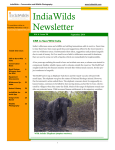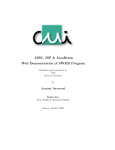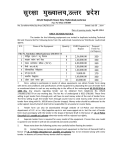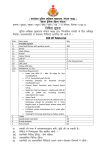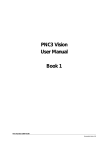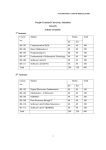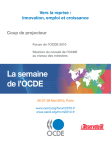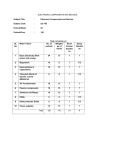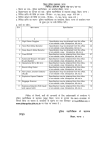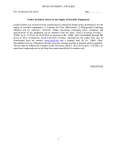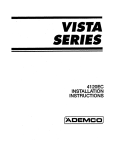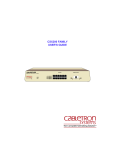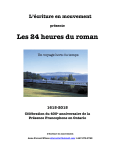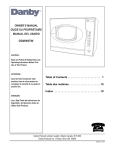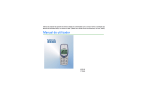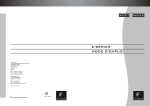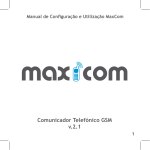Download R,qlqT {frffiq s*errq I
Transcript
Fnr€ru€ qrhfuo l-dr gi6rr TFIFI : 0132-26Gt70, 26G!71 tqr fsq i€ RreTr Ff6e-d. va. 2€634e E-mail- qRqq s-.s+1 (EtrdR) qrtrtho Erarsrs), onfigt -zrz mz [email protected] Website:www.ubter.in q, wrl-kT qftqq qErrflqrd/frtqro t R,qlqT trfi-fr I werq rrrl-kT {frffiq gtl /qrgqf s*errq I /err$.enq.S.A. / zot3-r+RTiq. 12 / or / zo,tz q*(rr, Fnf€rus erRfuo Rren.qR.Tq of rcqf-fi 24 q{ 2o1s o} g{ tlefiro Hm of tu-6 fr fut of wqrlqr^qrt gy ertqqT -.ri $efir6 Hfrfr q^ft+,taglf dfrut tg erEdfta q.#ot -ra 2013-14 t er.1 o1 urq g, ry gd t sqq srf*T ri{Qr- qfu qrflRf gq *FTT gfrtr{d \. "RrF fffrff qfte+rg Hvirtrd rft{ q6irwf et, enrlrft t di *rfi fu r ffiF=rqt - EftuTagaf fftr{u( q,fifurftrr il.q} efi .rft{ qrcqqqf t Lkwpuk r`rh; ,oa prqFkZ lsesLVj ds fofHkUu bathfu;fjax ikB~;Øeksa dh la”kksf/kr ikB~;p;kZ lq>koksa vkea=.k gsrq ifj’kn~ dh osclkbV ij izlkfjr dh xbZ FkhA rn~uqlkj izkIr mi;ksxh lq>koksa dks fo”ks’kK lewg ds lkFk eaFku ds mijkUr ikB~;p;kZ esa lekfgr dj fn;k x;k gSA l= 2013&14 ls ykxw dh tkus okyh bathfu;fjax ikB~;Øe gsrq r`rh; ,oa prqFkZ lsesLVj dh ikB~;p;kZ ifj’kn~ dh osclkbV ij izlkfjr dh tk jgh gSA ikB~;p;kZ esa ;fn dgha ij spelling/ Evaluation sheet ;k vU; dksbZ =qfV gksa rks Ñi;k v/kksgLrk{kjh dh E‐mail : [email protected] ij voxr djkus dk d’V djsaA ¼vkj0ih0xqIrk½ la;qDr lfpo vkbZ0vkj0Mh0Vh0 UTTARAKHAND BOARD OF TECHNICAL EDUCATION, ROORKEE CURRICULUM FOR DIPLOMA PROGRAMME IN INFORMATION TECHNOLOGY FOR UTTARAKHAND (Third & Fourth Semester Only) Approved by: UTTARAKHAND BOARD OF TECHNICAL EDUCATION ROORKEE 247 667 STUDY AND EVALUATION SCHEME FOR DIPLOMA PROGRAMME IN INFORMATION TECHNOLOGY THIRD SEMESTER Sr. No Subject L T P T 0 T Periods/Week Theory Practical Theory Max. Marks Max. Marks Max. Marks Hrs Total Marks Practical Max. Hrs Marks 3.1 * Programming in C 4 - 4 8 20 20 80 2.5 50 3.0 170 3.2 * Basics of Electrical and Electronics Engineering 4 - 3 7 20 20 80 2.5 50 3.0 170 3.3 Computer Workshop - - 5 5 - 20 - 2.5 80 3.0 100 3.4 * Computer System Peripherals 5 - 2 7 20 20 80 2.5 50 3.0 170 3.5 Computer Applications 4 - 4 8 20 20 80 2.5 50 3.0 170 3.6 * Operating Systems 6 - 3 9 20 20 80 2.5 50 3.0 170 General Proficiency # - - 4 4 - 25 - - - - 25 Industrial Exposure (Assessment at institute Level)+ - - - - - 25 - - - - 25 23 - 25 120 170 400 - 330 - 1000 Total * EVALUATION SCHEME Internal Assessment External Assessment (Examination) 48 Common with diploma programme in Computer Science and Engineering. # General Proficiency will comprise of various co-curricular activities like games, hobby clubs, seminars, declamation contests, extension lectures, NCC, NSS and cultural activities, elementary mathematics, GS & G.K etc. . + Industrial visit compulsory to minimum 2 Industries or Departments. Note: 1- Each period will be 50 minutes. 2- Each session will be of 16 weeks. 3- Effective teaching will be at least 12.5 weeks. FOURTH SEMESTER (INFORMATION TECHNOLOGY) EVALUATION SCHEME T L T P 0 T Sr. No External Assessment (Examination) Internal Assessment Subject Periods/Week Theory Practical Theory Practical Max. Marks 25 Max. Marks 100 Hrs Max. Hrs 2.5 Marks 50 3.0 200 4.1 Data Structure Using C * 5 - 4 9 Max. Marks 25 4.2 Object Oriented Programming using C++ 5 - 3 8 25 25 50 2.5 50 3.0 150 4.3 Computer organization & microprocessor 6 - 2 8 25 25 75 2.5 50 - 175 4.4 Internet and Web Technologies 4 - 3 7 25 25 50 2.5 50 3.0 150 4.5 * System and Software Engineering 5 - - 5 25 - 100 2.5 - - 125 4.6 Data Communication and Networks 5 - 2 7 25 25 50 2.5 50 3.0 150 4.7 Industrial Exposure (Assessment at Inst. Level)+ - - - - - 25 - - - - 25 4.8 Industrial Training General Proficiency # Total * Total Marks Industrial Training of 30 days done after 4th Semester would be evaluated in 5th semester through Report and Viva-voice - - 4 4 - 25 - - - - 25 30 - 18 48 150 125 600 - 125 - 1000 Common with diploma programme in Computer Science and Engineering. # General Proficiency will comprise of various co-curricular activities like games, hobby clubs, seminars, declamation contests, extension lectures, NCC, NSS and cultural activities, elementary mathematics, GS & G.K etc. + Industrial visit compulsory to minimum 2 Industries or Departments. Note: 1- Each period will be 50 minutes. 2- Each session will be of 16 weeks. 3- Effective teaching will be at least 12.5 weeks. THIRD SEMESTER 3. DETAILED CONTENTS OF VARIOUS SUBJECTS 3.1 PROGRAMMING IN ‘C’ L P Periods/week 4 4 RATIONALE Computers play a vital role in present day life, more so, in the professional life of technician engineers. People working in the field of computer industry, use computers in solving problems more easily and effectively. In order to enable the students use the computers effectively in problem solving, this course offers the modern programming language C along with exposition to various applications of computers. The knowledge of C language will be reinforced by the practical exercises. DETAILED CONTENTS 1. Algorithm and Programming Development (04 Periods) Steps in development of a program, Flow charts, Algorithm development, Debugging 2. Program Structure (06 Periods) I/O statements, assignment statements. Constants, variables and data types, Operators and Expressions, Use of Header files & Library functions, Key word, data Types and Identifiers 3. Control Structures (10 Periods) Introduction, Decision making with IF – statement, IF – Else and Nested IF, While and do-while, for loop, Break and switch statements 4. Functions (10 Periods) Introduction to functions, Function Declaration, Standard functions, Parameters and Parameter Passing, Call by value/reference, Global and Local Variables, Recursion 5. Arrays (8 Periods) Introduction to Arrays, Array Declaration and Initialization, Single and Multidimensional Array. Arrays of characters 6. Pointers (8 Periods) Introduction to Pointers, Address operator, pointer and functions, Declaring and Initializing pointers, Assignment through pointers, Pointers and Arrays 7. Structures and Unions (8 Periods) Declaration of structures, Accessing structure members, Structure Initialization, Arrays of structures, Unions, Memory allocation functions. 8. Strings (5 Periods) Introduction, Declaring and Initializing string variables, Reading and writing strings, String handling functions, Array of strings 9. Files (05 Periods) Introduction, File reading/writing in different modes, File manipulation using standard function types LIST OF PRACTICALS 1. Programming exercises on executing and editing a C program. 2. Programming exercises on defining variables and assigning values to variables. 3. Programming exercises on arithmetic and relational operators. 4. Programming exercises on arithmetic expressions and their evaluation 5. Programming exercises on formatting input/output using printf and scanf 6. Programming exercises using if statement. 7. Programming exercises using if – Else. 8. Programming exercises on switch statement. 9. Programming exercises on do – while statements. 10. Programming exercises on for – statement. 11. Programs on one-dimensional array. 12. Programs on two-dimensional array. 13. (i) Programs for putting two strings together. (ii) Programs for comparing two strings. 14. Simple programs using structures. 15. Simple programs using pointers. 16. Simple programs for reading from a file and writing into a file. INSTRUCTIONAL STRATEGY The subject is totally practical based. Students should be given clear idea about the basic concepts of programming. In practical session student should be asked to draw flow chart write algorithm and then write program for the algorithm and run on computer. It is required that students should maintain records (files with printouts). RECOMMENDED BOOKS 1. Programming in ANSI C by E Balaguruswami, , Tata McGraw Hill Education Pvt Ltd , New Delhi 2. Application Programming in C by RS Salaria, Khanna Book Publishing Co(P) Ltd. New Delhi 3. Programming in C by Gottfried, Schaum Series, , Tata McGraw Hill Education Pvt Ltd , New Delhi 4. Exploring C by Yashwant Kanetkar – BPB Publications, New Delhi 5. Programming in C by Stefin G. Coachin 6. Programming in C by R Subburaj, Vikas Publishing House Pvt. Ltd., Jangpura, New Delhi 7. Elements of C by M.H. Lewin, Khanna Publishers, New Delhi 8. Programming in C by Stephen G Kochan 9. Programming in C by BP Mahapatra, Khanna Publishers, New Delhi SUGGESTED DISTRIBUTION OF MARKS Topic No. 1 2 3 4 5 6 7 8 9 Time allotted (Period) 4 6 10 10 8 8 8 5 5 Marks Allotted (%) 6 10 16 16 12 12 12 8 8 Total 64 100 3.2 BASICS OF ELECTRICAL AND ELECTRONICS ENGINEERING Periods/week L 4 P 3 Rationale : The objective of this subject is to impart fundamental knowledge and skills regarding basic electrical and electronics engineering and digital electronics which diploma holders will come across in their professional life. This course will enable the students to understand the basic concepts and principles of d.c. and a.c. fundamentals, and batteries. The students will also learn basic electronics including diodes and transistors and their applications and digital electronics devices & systems. DETAILED CONTENTS 1. Overview (04 Period) Basic concepts of electrical parameters, AC and DC, Use of Electrical Engineering. Ohm’s law, Kirchhoff’s Law. Concept of voltages & current sources and their conversion. 2. AC fundamentals (04 Period) Representation of sinusoidal quantity, Equation of sinusoidal wave form, Simple RLC circuits 3. Batteries (06 Period) Basic idea about primary and secondary cells, Construction, working and applicants of Lead-Acid, Nickel-Cadmium and Silver oxide batteries, Charging methods used for lead-acid battery(accumulator), Care and maintenance of leadacid battery, Series and parallel connections of batteries, General idea of solar cells, solar panels and their applications, Introduction to maintenance free batteries. 4. Semi Conductor Physics (04 Period) Conductors, Insulators, Semiconductors, Idea of Energy Level, Energy Band Diagrams of Insulators, Conductors and Semiconductors, Effect of Temperature, Recombination of holes and electrons, n-type semiconductor, p-type semiconductor, Majority and Minority Carriers. 5. Semi Conductor Diode & Transistor (06 Period) Mechanism of current conduction and characteristics of ordinary diode, zener diode, LED, Principle of operation characteristics and applications of BJT and concept of configurations. 6. Electrical & Electronics Measuring Instruments (06 Period) Operations methods and applications of induction type energy meter, Analog/ Digital multimeter, CRO 7. Earthing & Discharge (04 Period) Concept of earthing and grounding, importance of Earthing, Mechanism and procedure of earthing provided in computer centre, checking of earthing, Static Discharge, Methods to reduce discharge, Provision for the safety of computers from high electrical discharge, Magnetic effect etc. 8. Number System (06 Period) Distinction between analog and digital signal, Applications and advantages of digital signals ,Binary, Octal and hexadecimal number system: conversion from decimal and hexadecimal to binary and vice-versa, binary addition, subtraction, multiplication and division including binary points. 1’s and 2’s complement method of addition/subtraction. 9. Codes and Parity (04 Period) Concept of code, weighted and non-weighted codes, examples of 8421, BCD, excess-3 and Gray code, Concept of parity, single and double entry and error detection, Alpha numeric codes : ASCII and EBCDIC 10. Logic Gates and Families (04 Period) Concept of negative and positive logic, Definition, Symbols and truth tables of NOT, AND, OR, NAND, NOR, EXOR Gates, NAND and NOR as universal gates, Logic family classification: Definition of SSI, MSI,LSI, VLSI,TTL and CMOS families. 11. Logic Simplification (04 Period) Postulates of Boolean algebra, De Morgan’s Theorems . Various identities. Formulation of truth table and Boolean equation for simple problem. Implementation of Boolean (logic) equation with gates. Karnaugh map (upto 4variables) and simple applications in developing combinational logic circuits. 12. Arithmetic Circuits (04 Period) Half adder and Full adder circuit, design and implementation, Half and Full subtractor circuit, design and implementation, 4 bit adder/subtractor, Adder and Subtractor IC 13. Decoders, Multiplexers and De Multiplexers (04 Period) Four bit decoder circuits for 7 segment display and decoder/driver ICs, Multiplexers and De-Multiplexers, Basic function and block diagram of MUX and DEMUX. Different types and ICs. 14. Latches and flip flops (04 Period) Concept and types of latch with their working and applications, Operation using waveforms and truth tables of RS, T, D, Master/Slave JK flip flops, Difference between a latch and a flip flop. LIST OF PRACTICALS 1. Verification of Kirchoff’s current law and voltage law in a D.C. Circuit. 2. To test a lead – acid storage battery for charged & discharged condition (with hydrometer & to recharge it) 3. Use of analog & digital multimeter and measure resistance, voltage & current. 4. Use of CRO & measurement of frequency & voltage. 5. Verification & interpretation of truth tables for AND, OR, NOT NAND, NOR and Exclusive OR (EX-OR) gates. 6. To design a half adder & full adder using gates and verification of their operation construction of a full adder circuit using XOR and NAND gates and verify its operations. 7. To design a half subtractor & full subtractor circuit with the help of gates & verify their operations. 8. Verify of truth table for decoder ICs. 9. Verification of truth table of JK & JK Master slave flip flops. 10. Verification of MUX & DEMUX using ICs 11. To find the voltage & currant relationship in single phase RLC circuit 12. Draw V.I. characteristics of ordinary semiconductor diode & LED. 13. Draw input & output characteristics of transistor in CB & CE configurations. 14. Demonstration of earthing, provided for computer center & testing of proper earthing. INSTRUCTIONAL STRATEGY The Electrical, Analog and digital systems have significant importance in the area of computer. Adequate competency needs to be developed by giving sufficient practical knowledge in Electrical, Electronics and digital circuit. Help may be taken in the form of charts, simulation packages to develop clear concepts of the subject. LIST OF RECOMMENDED BOOKS 1. Digital Electronics: Principles and Integrated Circuits by A.K Maini, Wiley-India Pvt Ltd. Daryaganj, New Delhi 2. Digital Electronics and Applications by Malvino Leach, Tata McGraw Hill Education Pvt Ltd, New Delhi 3. Digital Logic Designs by Morris Mano, Prentice Hall of India, New Delhi 4. Digital Electronics by Soumitra Kumar Mandal, Tata McGraw Hill Education Pvt Ltd, 5. Digital Electronics by V K Sangar , Raj Publishers, Jalandhar 6. Digital Electronics by Tokheim, Tata McGraw Hill Education Pvt Ltd, 7. Digital Electronics by RP Jain, Tata McGraw Hill Education Pvt Ltd, New Delhi 8. Digital Electronics by KS Jamwal, Dhanpat Rai and Co., New Delhi 9. Digital Electronics by Rajiv Sapra, Ishan Publication, Ambala 10. Digital Electronics by BR Gupta, Dhanpat Rai & Co., New Delhi 11. Digital Systems: Principles and Applications by RJ Tocci, Prentice Hall of India, New Delhi 12. Digital Electronics by Rajaraman V., Prentice Hall of India, New Delhi 13. Fundamentals of Digital Electronics by Naresh Gupta, Jain Brothers, New Delhi 14. Principle of Electrical Engineering by V.K. Mehta, S Chand Publication. 15. Basic Electrical Engineering by J.B. Gupta, S.K. Kataria & sons 16. Basic Electrical Engineering by Sahdev & Sahdev, Uneek Publication 17. Fundamental of Elex for polytechnics by Subhadeep Chaudhary, Paragon international Publication 18. Electrical machines by S.K. Bhattacharya Tata McGraw Hill Education Private Limited. SUGGESTED DISTRIBUTION OF MARKS Topic No. 1 2 3 4 5 6 7 8 Time allotted (Period) 04 04 06 04 06 06 04 06 Marks Allotted (%) 05 05 05 05 10 10 05 10 9 04 05 10 04 05 11 04 10 12 04 05 13 04 10 14 04 10 Total 64 100 COMPUTER WORKSHOP L T P - - 5 RATIONALE The course aims at making the students familiar with various parts of computers, peripherals and various operating systems. In addition, the course will provide the students with necessary knowledge and skills in computer software installation, maintenance and make him comfortable to diagnose computer system faults. DETAILED CONTENTS 1. Components and parts of personal computers Mother-Board Details, Hard Disk: SATA, PATA, File Systems: FAT, NTFS, Partitioning Hard Disk, Using Partition Megic Software, External Hard Disk Drive, Floppy Disk Drive, CD/ DVD Drive, RAM, CMOS/BIOS Configuration, Update BIOS Software. 2. Installation of Operating Systems Study & Configuration of BIOS, Create Bootable: USB, CD and DVD, Installation of Operating System: Unix, Linux, Windows, Mac OS, Working With OS: Define Users, Groups, Profiles, and Policies, Manage Users, Groups, Profiles, and Policies, Use Security and Access Controls, Remote Access. 3. Installation of application softwares Installation and configuration of Microsoft Visual Studio, J2SDK-SE, J2SDK-EE, J2SDK-ME, database softwares :sql server, oracle, web servers: Apache Tomcat, JRUN, IIS, Installation of drivers: Network, Display, Sound and Chipset. 4. Firewall & Security Softwares Installation of Firewal Softwares, Configuring Firewall, Antivirus Softwares, Virus Detection, Cure and Recovery. 5. Printer & Scanner Installation & Sharing of Printer, Installation & Sharing of Scanner, Installation of Overhead Projector. 6. Remote & : Source/Version Control Softwares Installation Configuration & Working With: Source/Version Control Softwares (TFS, VSS, SOS), Remote Control Softwares (Hemachi, TeamViewer, Ultra VNC). 7. Troubleshooting of Windows Command-line tools and Recovery Console, Use DOS commands on files & disks, Backup strategies: Perform normal and incremental backups, Restore files from normal, incremental backups, Using Windows Backup, Using System Restore, Describe the Booting process, Boot with various boot options, Create Setup and Emergency Repair Disk, Use the Check Disk utility, Windows Registry: Windows Registry Editor, Structure and Organization of Registry, Export and Edit Registry settings. INSTRUCTIONAL STRATEGY As the subject is fully practical oriented, sufficient exercises on installation of operating systems and application softwares should be given. Exercises in repair and fault finding of computer and peripheral devices like printers, display devices, disk drive should be given to the student. Field visits too the places where Installation of computers is taking place will be helpful to the students. RECOMMENDED BOOKS 1. 2. 3. 4. 5. Modern Computer Hardware Course by Manahar Lotia (Author) BPB (Publisher) PC Upgrade of Maintenance Guide 16th Edition by Mark Minasi, BPB (Publisher) Windows NT 4: The Complete Reference by Griffith Kadnier (Author), McGraw-Hill A+ Guide to PC Hardware Maintenance & Repair By Michael Graves (Author) Comptia A+ Certification Study Guide, 7th Edition By Jane Holcombe,Charles Holcombe (Auther) 6. Comptia A+ Guide: Essentials Lab Manual, Third Edition By Michael Meyers (Author) 3.4 COMPUTER SYSTEM PERIPHERALS Periods/week LTP 5- 2 RATIONALE A computer engineer should be able to interface and maintain key-board, printer, mouse, monitor etc along with the computer system. The course provides the necessary knowledge and skills regarding working construction and interfacing aspects of peripherals. The students will get to know how various peripherals communicate with central processing unit of the computer system. The student will be able to maintain keyboard, printer, monitors and Power Supplies (CVTs and UPSs) along with computer system. This subject provides the required background of computer installation, maintenance and testing of peripherals with microcomputers. DETAILED CONETENTS 1. Video Display (10 Period) The basic principle of working of video monitors(CRT/TFT/LCD/LED), video display adapters, video modes Video display EGA/VGA/SVGA/PCI adapters and their architecture 2. Key Board and Mouse (8 Period) Types and basic principle of working of wired /wireless key board and wired /optical/wireless mouse, scan codes. 3. Disk Drivers (14 Period) Features and working of hard disk drive, floppy disk drive, optical and DVD disk drives and CD writer, Pen Drive, Logical structure of disk and its organization and boot record 4. Peripheral Devices, Ports and Connectors (14 Period) Working principle of various input devices such as Scanner, Tablets, touch screen, light pen, digitizers and joystick, Serial, Parallel, PS/2, USB, RJ- 45, BNC 5. Printers (14 Period) Principle and working of deskjet, Inkjet, dot matrix and laser printers and plotters 6. Networks Peripherals (Features and Working) (12 Period) Hub, Switches, Gateway, Router, Bridge, Modem, Patch Panel, I/O Box, Patch Cord, Wireless access point, LAN card(wired/wireless access) 7. Power Supplies (Working Principle) (8 Period) SMPS, Constant voltage transformers, On Line/Off Line uninterrupted power supplies (UPS) LIST OF PRACTICALS 1) 2) 3) 4) 5) 6) 7) To identify various components and peripheral devices of computer. Demonstration of different Peripherals of a computer system. To study the operation of SMPS To study the operation of CVT. To study the operation of UPS. To study the Video display Unit To study the Network Connections INSTRUCTIONAL STRATEGY While teaching the subject the teacher may take the interfacing devices like disk drives, printers, key-boards, scanners, plotters etc. physically and explain its working. Additional practical exercise on maintenance and repair of peripheral devices will help the students to develop adequate skills. LIST OF RECOMMENDED BOOKS 1. 2. 3. 4. 5. 6. 7. 8. B. Govinda Rajalu, IBM PC and Clones. Hardware Trouble Shooting and Maintenance, Tata McGraw Hill 1991 Robert, S Lai: The waite group writing MS DOS Device, Drives, Addison, Wesley Publishing Co. 2nd Ed. 1992. SK Bose “Hardware and Software of Personal Computers” Wiley Eastern Limited, New Delhi. Hall, Douglas “Microprocessors and Interfacing” McGraw Hill Uffenbeck, Microprocessors and Interfacing Sukhvir Singh, Fundamental of Computers, Khanna Publishers, New Delhi Levis Hahensteu, Computer Peripherals for Micro Computers, Microprocessor and PC Peter Norton, Inside the PC (Eight Edition), Tech media SUGGESTED DISTRIBUTION OF MARKS Topic No. 1 2 3 4 5 6 7 Total Time allotted (Period) 10 08 14 14 14 12 08 80 Marks Allotted (%) 12 10 18 18 18 14 10 100 3.5 COMPUTER APPLICATIONS Periods/week L T P 4 - 4 RATIONALE The objective of this subject is to enable the students to understand the fundamentals of multimedia and to work on MS Office, Photoshop and Coral Draw. Using these software, students will be able to create business cards, pamphlets, banners, news papers, and books. DETAILED CONTENTS 1. Features and Applications of MS Office (15 Periods) Fundamentals of MS Word: Using all tools & effect of text formatting, Importing and Exporting files and images, tables formatting, border, Charts/ Graphs, Forms, Tools, Equations and macros function, Mail Merge concept. Features & applications of Excel, Rows, Columns, Cell Menus; Creating Worksheets; Appling formula and function , formatting, Printing, Graph/ Charts, Establishing worksheet links, Macros, Database, Tables; Features, Applications, Views, Create slide presentation, Slide Show, Animation and Printing Presentation, Multimedia feature 2. Desktop Publishing (04 Periods) Overview, features, applications and advantages of Desktop Publishing 3. Page-Maker (10 Periods) An introduction, basics menus & tools, Guides & rulers, Drawing tools, Fills & outlines, Working with- text, paragraphs, tabs & indents, graphics, tables, Importing & exporting, story editing and printing, Tips and Shortcut key, Creating book works-introductionbuilding booklets, completing the book. 4. CorelDraw (10 Periods) Corel draw –An overview, menus and tools, Drawing –lines, shapes .inserting-pictures, objects, tables, templates, Adding special effects, Exporting drawings, outlining & filling objects, inserting symbols & Clip arts, Working in Corel draw presentation –adjusting the position, resizing, positioning, merging, color shades & shadows .working with advanced effects, special interactive effects, Creating- business cards, pamphlets, banners, news papers, books. Shortcut keys in Corel draw. 4. Photo-shop (15 Periods) Creating converting and viewing and graphic documents including: PD and PS Files Using Adobe Acrobat Reader, Inserting picture and shapes, filling colors, text effects, working with layers, filters, Creating design patterns, Photoshop presentations -static & dynamic presentation, WEB & WEB GALLERY using internet explorer in photo shop, creating animations using image ready, creating animations & presentations, Tips and tricks in Photoshop. 6. Introduction to Printing (10 Periods) Types of Printing an Introduction-Letterpress printing-lithography-offset printingdifferent printing process-machines for letterpress, offset, gravure, flexography and screen printing-printing materials, planning a printing, design factors, color applicationfilm assembly and plate making-binding & finishing, Image editing, color correction, color management, poly master, methods of color proofing, Different types of font, text file formats, vector & raster graphics, graphics file formats, Page setting, character & paragraph formatting, indentation, alignments, hyphenation, single & double sided documentation. LIST OF PRACTICALS 1. 2. 3. 4. 5. 6. 7. 8. 9. 10. 11. 12. 13. 14. 15. Exploring settings using windows control panel16 Creating, editing and formatting documents using MS Word, macro function and Mail Merge concept using MS Word Creating and manipulating worksheets using MS Excel, MS Excel functions and formulas, MS Excel charts and Graphs Creating, attractive presentations including about the department, about your institute and course material using MS Power Point, insert a picture in the existing image background? Create a 3D text in Corel Draw Create an advertisement for a Textile company in Corel Design a business card for a company embed photo in it. Design a banner for a marriage function Making presentations including diagrams, charts, graphics and images using CorelDraw Creating 2-fold, 3- fold, 4-fold, 6- fold cards and brochures using CorelDraw Creating, Converting and opening PD and PS files To make smooth curved lines in Photoshop Extract an object from a given picture Create a new picture. Make it 300 pixels high and 400 pixels wide. The resolution should be 72 pixels / inch. To create your very own animated beating heart in Photoshop To make falling objects that will work as seamless backgrounds and have objects falling at different paces in Photoshop INSTRUCTIONAL STRATEGY This course is more of practical importance hence care should be taken to use as many features as possible of the tools discussed in theory more effectively and efficiently RECOMMENDED BOOKS 1. 2. Photoshop 7 The Complete Reference By Laurie Ann Ulrich, McGraw Hill Professional R.K. Teral: PC Software made simple, Tata Mc Graw Hill 3. 4. 5. 6. 7. 8. 9. 10. 11. Crawford and Russel: Getting Ready for Windows 95, BPB Publication Russel A. Stultz: Learn Excel for Windows in a day, BPB Publication Mansfield: Mastering Word 6.0 for Windows, BPB Publications. Peter Dyson: Understanding PC Tools, Sybex/ Tech. Asian Ed., Tech. Pub User guide, Adobe page Maker 6.5 CorelDraw 8 user Manual Corel Photo Paint 8 user Manual Quark- Express 7 user Manual Steve Rimmer, Mastering CorelDraw 3 Tech publications PTE. Ltd William D. Harrell; Illustrated Page Maker 4.0, Jaiko Book SUGGESTED DISTRIBUTION OF MARKS Topic No. 1 2 3 4 5 6 Total Time allotted (Period) 15 4 10 10 15 10 64 Marks Allotted (%) 24 6 16 16 22 16 100 3.6 OPERATING SYSTEMS LTP Periods/week 6 - 3 RATIONALE The course provides the students with an understanding of human computer interface existing in computer system and the basic concepts of operating system and its working. The students will also get hand-on experience and good working knowledge to work in DOS and Windows environments. The aim is to gain proficiency in using various operating systems after undergoing this course. DETAILED CONTENTS 1. Brief Introduction to System Software (4 Period) Compiler, Assembler, Loader, Operating system, Linking, Loading and Executing a Program 2. Overview of Operating Systems (8 Period) Definition of Operating Systems, Functions of Operating System, Types of Operating Systems – Batch Processing, Time Sharing, Multiprogramming, Multiprocessing and Real Time Systems, Distributed Systems, Importance of Operating System 3. Process Management Functions (16 Period) Job Scheduler, Scheduling Criteria, Process Scheduler, Scheduling algorithms, Process synchronization, Critical section 4. Dead Locks (16 Period) Introduction and necessary conditions of dead lock, Dead lock avoidance, Dead lock detection, Dead lock Recovery 5. Memory Management Function (20 Period) Introduction, Logical and Physical address space, Virtual memory, Swapping, Single contiguous memory management, Fixed partition, Contiguous allocation, Paging, Segmentation, Demand paging, Page replacement algorithms, Thrashing 6. I/O Management Functions (16 Period) Dedicated Devices, Shared Devices, Virtual Devices, Storage Devices, Buffering, Spooling 7. File Management (16 Period) File concept, Access Methods, Directory Structure, Protection, File system structure, allocation methods, Directory implementation LIST OF PRACTICALS 1. Demonstration of all the controls provided on Control Panel, and exercises using Windows 2. Practical exercises involving various internal and external DOS commands 3. Practical exercises involving various UNIX/LINUX commands INSTRUCTIONAL STRATEGY As per the above information, it is clear that the subject is both theory and practical oriented. Therefore, the stress must be given on both the theory and practical teaching. In the practical classes, the laboratory must be equipped with all the basic operating system software i.e DOS, UNIX, LINUX, WINDOWS etc. While imparting instructions, the teachers are expected to lay more emphasis on concepts and principles of operating systems, its features and practical utility. LIST OF RECOMMENDED BOOKS 1. Operating systems by John J Donovan; Tata McGraw Hill, New Delhi 2. Operating System Concept by Ekta Walia, Khanna Publishers, New Delhi 3. System programming by Dhamdhare 4. Unix operating system by Vijay Mukhi 5. Operating system by C. Ritchie 6. MS DOS by Peter Norton, BPB Publications 7. Microsoft Windows Manual 8. First Course in Computers by Sanjay Saxena; Vikas Publishing House Pvt. Ltd., Jungpura, New Delhi SUGGESTED DISTRIBUTION OF MARKS Topic No. 1 2 3 4 5 6 7 Total Time allotted (Period) 04 08 16 16 20 16 16 96 Marks Allotted (%) 04 08 16 18 22 16 16 100 FOURTH SEMESTER 4. DETAILED CONTENTS OF VARIOUS SUBJECTS 4.1 DATA STRUCTURES USING C L T P Periods/week 5 - 4 RATIONALE Data structures are the techniques of designing the basic algorithms for real-life projects. Understanding of data structures is essential and this facilitates the understanding of the language. The practice and assimilation of data structure techniques is essential for programming. The knowledge of ‘C’ language and data structures will be reinforced by practical exercises during the course of study. The course will help students to develop the capability of selecting a particular data structure. DETAILED CONTENTS 1. Fundamental Notations (08 Periods) Problem solving concept, top down and bottom up design, structured programming, Concept of data types, variables and constants, Concept of pointer variables and constants 2. Arrays (10 Periods) Concept of Arrays, Single dimensional array, Two dimensional array storage strategy of multidimensional arrays, Index Formula for single and multidimensional Array, Operations on arrays with Algorithms (Insertion, deletion), Advantages and disadvantages. 3. Linked Lists (14 Periods) Introduction to linked list and double linked list, Representation of linked lists in Memory, Traversing a linked list, Searching linked list, Insertion and deletion into linked list, Application of linked lists, Doubly linked lists, Traversing a doubly linked lists, Insertion and deletion into doubly linked lists 4. Stacks, Queues and Recursion (10 Periods) Introduction to stacks, Representation of stacks, Implementation of stacks using Array & Link List, Uses of stacks, Introduction to queues, Implementation of queues (with algorithm), Circular Queues, De-queues, Recursion. 5. Trees, Graph and Table (24 Periods) Concept of Trees, Concept of representation of Binary tree, Binary search trees Traversing Binary Trees (Pre order, Post order and In order), Searching, inserting and deleting binary search trees, AVL Tree, B-Tree, Introduction to graphs, types of graphs, Breadth first search, Depth first search, Adjacent matrix,Searching Sequential table, Hash tables 6. Sorting and Searching (14 Periods) Introduction, Search algorithm (Linear and Binary), Concept of sorting, Sorting algorithms (Bubble Sort, Insertion Sort, Quick Sort, Selection Sort, Merge Sort, Heap Sort, Radix Sort) and their comparisons, Complexity Analysis of Sorting Algorithms. LIST OF PRACTICALS Write programs in C to implement 1. 2. 3. 4. 5. 6. 7. 8. 9. 10. 11. 12. 13. 14. 15. 16. 17. Inserting and deleting elements in an array Insertion and deletion of elements in linked list Insertion and deletion of elements in double linked list Stack implementation using arrays Stack implementation using pointers Queue implementation using arrays Queue implementation using pointers Linear search in a given list Binary search in a given list Implementation of binary search tree Implementation of bubble sort algorithm Implementation of insertion sort algorithm Implementation of quick sort algorithm Implementation of selection sort algorithm Conversion from infix and post-fix notation Implementation of factorial of a number using recursion Implementation of Fibonacci series using recursions INSTRUCTIONAL STRATEGY This subject clears all fundamentals of programming techniques. Teachers should stress on explaining all the techniques and algorithm in detail in theory sessions. The students should be asked to convert their ideas about a problem into and algorithms in theory class and them write programs for the algorithms. Finally all the programs should be run on computers. This will help the students to have clear concepts of programming. RECOMMENDED BOOKS 1. Data structures – Schaum’s Outline Series by Lipschutz; McGraw Hill Education P Ltd , New Delhi 2. Data Structures using C and C++ by Rajesh K. Shukla; Wiley-India Pvt Ltd. Daryaganj, New Delhi 3. Data Structures and Algorithm Using C by RS Salaria; Khanna Book Pub. Co. (P) Ltd. New Delhi 4. Data Structure using C by Manoj Kumar Jambla; Eagle Publishing House, Jalandhar 5. Expert Data Structures with C by R.B. Patel; Khanna Publishers, New Delhi. 6. Data Structure through C by Yashwant Kanekar; BPB Publications SUGGESTED DISTRIBUTION OF MARKS Topic No. 1 2 3 4 5 6 Total Time allotted (Period) 8 10 14 10 24 14 80 Marks Allotted (%) 10 12 18 12 30 18 100 4.2 OBJECT ORIENTED PROGRAMMING USING C++ L T P Periods/week 5 - 3 RATIONALE Object orientation is a new approach to understand the complexities of the real world. In contrast to the earlier approaches like procedural etc, object orientation helps to formulate the problems in a better way giving high reliability, adaptability and extensibility to the applications. The students are already familiar with this concept of programming in C which is the basic for C++. This course offers the modern programming language C++ that shall help the students to implement the various concept of object orientation practically. The students will be able to programme in the object oriented technology with the usage of C++. DETAILED CONTENTS 1. Introduction and Features (06 Periods) Introduction, procedure oriented programming Vs. object oriented programming (OOP)., differentiate C & C++, Object oriented programming concepts – object, Classes, reusability, encapsulation, inheritance, polymorphism, dynamic binding, message passing and data hiding 2. Language Constructs (14 Periods) Review of constructs of C used in C++ : variables, types and type declarations, user defined data types; increment and decrement operators, relational and logical operators; if then else clause; conditional expressions, input and output statement, loops, switch case, arrays, structure, unions, functions, pointers; preprocessor directives 3. Classes and Objects (08 Periods) Creation, accessing class members, Private Vs Public, Constructor and Destructor Objects 4. Member Functions (08 Periods) Method definition, Inline functions implementation, Constant member functions, Friend Functions and Friend Classes, Static functions 5. Overloading Member Functions (10 Periods) Need of operator overloading, operator overloading, instream / outstream operator overloading function overloading, constructor overloading 6. Inheritance (14 Periods) Definition of inheritance, protected data, private data, public data, inheriting constructors and destructors, constructor for virtual base classes, constructors and destructors of derived classes, and virtual functions, size of a derived class, order of invocation, types of inheritance, single inheritance, hierarchical inheritance, multiple inheritance, hybrid inheritance, multilevel inheritance 7. Polymorphism and Virtual Functions (10 Periods) Importance of virtual function, function call binding, virtual functions, implementing late binding, need for virtual functions, abstract base classes and pure virtual functions, virtual destructors 8. File and Streams (10 Periods) Components of a file, different operation of the file, communication in files, creation of file streams, stream classes, header files, updating of file, opening and closing a file, file pointers and their manipulations, functions manipulation of file pointers, detecting end-of-file. LIST OF PRACTICALS 1 2 3 4 5 6 7 8 9 Programming exercises on control flow statements in C++ Programming exercises on arrays, strings, function and pointers in C++ Writing programs to construct classes and deriving objects Writing programs for constructors, destructors, using public and private access specifies Programming exercises on operator overloading, type conversions and inheritance Programming exercises on functional overloading Writing programs on steam computation and life operations Implementation of a mini project in C++ Introduction to latest ANSI C++ Compiler and elaboration of short comings of Turbo C++ Compiler INSTRUCTIONAL STRATEGY Since the entire course is totally practical oriented, it is strongly intended that after discussing the individual concepts in class, the students shall be asked to write the programmes for the same in the practical class. The theory and practical shall go hand in hand. It is required that the students make a file of practical exercises which may include the problem definition, algorithms flow charts (wherever required) and the print outs for each listed practical RECOMMENDED BOOKS 1) Object Oriented Programming in C++ by E. Balaguruswamy, Tata McGraw Hill Education Pvt Ltd , New Delhi 2) C++ by Robert Lafore, Galgotia Publications Pvt. Ltd., Daryaganj, New Delhi 3) Schaum’s Outline of Programming with C++ by John R. Hubbard 4) The C++ Programming Language by Bjarne Stroustrup Pearson Education New Delhi 5) 6) Object Oriented Programming and C++ by R Rajaram; New Age International (P) Ltd., Publishers, New Delhi Object Oriented Programming using C++ by Vipan Arora, Eagle Publication, Jalandhar 7) Object Oriented Programming using C++ by RS Salaria 8) Object Oriented Programming by D Ravi Chandran Tata McGraw Hill SUGGESTED DISTRIBUTION OF MARKS Topic No. 1 2 3 4 5 6 7 8 Total Time allotted (Period) 6 14 8 8 10 14 10 10 80 Marks Allotted (%) 8 18 10 10 12 18 12 12 100 4.3 COMPUTER ORGANIZATION AND MICROPROCESSOR L T P Periods/week 6 - 2 RATIONALE The subject provides the students with the knowledge of architecture and organization of personal computers. Computer airthematic algorithms for different arithmetic operations. The study of microprocessors in terms of architecture, software and interfacing techniques leads to the understanding of working of CPU in a microcomputer. DETAILED CONTENTS 1. Evolution and Architecture of a Microprocessor (16 period) Computer System organization and architecture. Typical organization of a microcomputer system and functions of its various blocks. Concept of Bus, bus organization of 8085, Functional block diagram of 8085 and function of each block, Pin details of 8085 and related signals. 2. Micro Programming (20 period) A. Brief idea of machine and assembly languages, assembler, program loops, programming arithmetic, and logic operations, sub routines, input- output programming with examples B. 8085 micro processor assembly language programming Machines and Mnemonic codes, Instruction format and Addressing mode. Identification of instructions as to which addressing mode they belong. Concept of Instruction set. Explanation of the instructions of the following groups of instruction set. Data transfer group, Arithmetic Group, Logic Group, Stack, I/O and Machine Control Group. Programming exercises in assembly language. (Examples can be taken from the list of experiments). 3. Instruction Timing and Cycles (08 period) Instruction cycle, machine cycle and T-states, Fetch and execute cycle 4. Interrupts (08 period) Concept of interrupt, Maskable and non-maskable, Edge triggered and level triggered interrupts, Software interrupt, Restart interrupts and its use. 5. Data transfer techniques (08 period) Concept of programmed I/O operations, input output interface, sync data transfer, async data transfer (hand shaking), Interrupt driven data transfer, DMA, 6. Micro Programmed Control Control memory, address sequencing, micro programs example (10 Period) 7. Computer Processing (10 Period ) Pipeline and vector processing, parallel processing, pipelining, arithmetic pipelines, RISC pipelines, Vector processing, array processors. 8. Computer Arithmetic Algorithm (16 Period) Addition and Subtraction algorithm, multiplication algorithms, division algorithms, floating point arithmetic operations LIST OF PRACTICALS 1. Familiarization of different keys of 8085 microprocessor kit and its memory map 2. Steps to enter, modify data/program and to execute a programme on 8085 kit 3. Writing and execution of ALP for addition of two 8 bit numbers 4. Writing and execution of ALP for substation of two 8 bit numbers 5. Writing and execution of ALP for multiplication of two 8 bit numbers 6. Writing and execution of ALP for division of two 8 bit numbers 7. Writing and execution of ALP for arranging 10 numbers in ascending order 8. Writing and execution of ALP for arranging 10 numbers in descending order LIST OF RECOMMENDED BOOKS 1. 2. 3. Computer Architecture by Rafiquzzaman, M; Prentice Hall of India, New Delhi Fairhead- 80386/80486, BPB Publication, New Delhi Hardware and Software of Personal Computers by Bose, SK; Willey Eastern Ltd., New Delhi 4. Structured Computer Organization by Tanenbaum, Andrew S; Prentice Hall of India, New Delhi 5. Upgrading and preparing PCs by Scott Muller, Techmedia Publications 6. Computer Organization and Architecture by Linda Labur, Narosa Publishing House Pvt, Ltd., Darya Ganj, New Delhi Microprocessor Architecture, Programming and Applications with 8080/8085 by Ramesh S Gaonker, Willey Eastern Ltd. New Delhi 7. Introduction to Microprocessor by Mathur ,Tata McGraw Hill Education Pvt Ltd , New Delhi 8. Microprocessor and Microcontrollers by Dr B P Singh, Galgotia Publications, New Delhi 9. Microprocessor and Applications by Badri Ram: Tata McGraw Hill Education Pvt Ltd , New Delhi 10. Microprocessor and Microcomputers by Refiquzzaman, Prentice Hall of India Ltd., New Delhi 11. Digital Logic and Computer Design by Mano, M Morris; Prentice Hall of India, New Delhi 12. Digital Electronics and Applications by Malvino Leach; Publishers McGraw Hill, New Delhi 13. Digital Integrated Electronics by Herbert Taub and Donals Sachilling; Prentice Hall of India Ltd., New Delhi 14. Digital Electronics by Rajaraman; Prentice Hall of India Ltd., New Delhi 15. Digital Electronics and Microprocessor by Rajiv Sapra, Ishan Publication, Ambala SUGGESTED DISTRIBUTION OF MARKS Topic No. 1 2 3 4 5 6 7 8 Total Time allotted (Period) 16 20 08 08 08 10 10 16 96 Marks Allotted (%) 10 30 10 10 10 10 10 10 100 4.4 INTERNET AND WEB TECHNOLOGIES L T P Periods/week 4 - 3 RATIONALE This course will enable the students to understand the basics of internet and various application of internet like e-mail, FTP, Telnet, Newsgroups and video conferencing In addition, this course develops competency amongst the students to design professional web sites and interactive web pages. They will have overview of different technologies like of HTML, DHTML, XML, CGI, Java Scripts, PHP, My Sql. DETAILED CONTENTS 1. Internet Basics (10 Periods) Specification and technical details for establishing Internet. Types and functions of modems, IP addressing, internet domains, domain name server, TCP/IP protocols, Internet service providers, Intranets, E-mail, Telnet, FTP, IRC, NNTP, Video conferencing, e-commerce, Internet connecting media 2. World Wide Web (WWW): (08 Periods) World Wide Web and its evolution, web page, web server, HTTP protocol. Examples of web servers, Navigation Tools: Mozilla Firefox, Google Chrome, Internet Explorer, Uniform Resource Locator (URL). Hypertext, hyperlinks and hypermedia, URL, its registration, browsers, search engines, proxy servers, Common Gateway Interface (CGI) 3. Web pages development: (10 Periods) Introduction to HTML-5 and CSS-3 Basic structure of HTML, designing a web page, inserting links images, horizontal rules, comments, Formatting text, title, headings, colors, fonts, sizes, simple tables and forms. HTML tags, hyperlinks. Adding graphics and images, image maps, image files, Using tables, forms, style sheets and frames 4. Client-side Scripting: (12 Periods) Introduction to Java Script, event handling, verifying forms, working with browser Windows, embedding with HTML ,Operator and expression, control statements, loop, array, Java Script Event Modeling, Validating Forms using Java script, data base connectivity, developing interactive website using Java script 5. Server-side Programming using PHP: (12 Periods) Basic, Intro, Install, Syntax, Variables, String, Operators, If...Else, Switch, Arrays, Sorting Arrays, While Loops, For Loops, Functions, Forms, $_GET, $_POST, Advanced, Arrays Multi, Date, Include, File, File Upload, Cookies, Sessions, E-mail, Secure E-mail, Error , Exception, Filter 6. Database Programming: (12 Periods) Database, MySQL Intro, MySQL Connect, Create DB, Table, Queries, ODBC, XML: XML Expat Parser XML, DOM XML, Simple-XML, AJAX: AJAX Intro AJAX, AJAX Database, AJAX XML AJAX Live Search AJAX RSS Reader AJAX Poll LIST OF PRACTICALS 1. Configuring computer system to access internet 2. Creation and use of e-mail 3. Searching of information using search engine 4. Creating Web pages using HTML 5. Creating web pages using front page 6. Design of Forms using Java Script 7. Validation of user queries and responses in the Forms using Java Script 8. Design of Forms using Java Script 9. Design of Forms using Java Script or Visual Basic Script 10. Validation of user queries and responses in the Forms using Java Script 11. Create a Homepage with frames, animation, background sound and hyperlinks 12. Design fill-out form with text, check box, radio buttons etc and embed Java script to validate users input. INSTRUCTIONAL STRATEGY Students should be exposed to Internet as the subject is practice oriented, theoretical Instruction may be given during practical session also. RECOMMENDED BOOKS 1. 2. 3. 4. 5. 6. 7. 8. 9. 10. 11. 12. 13. Internet and Web Technologies by Rajkamal, Tata McGraw Hill Education Pvt Ltd , New Delhi Internet 6-in-1 by Kraynak and Habraken, Prentice Hall of India Pvt. Ltd., New Delhi Using the Internet IV edition by Kasser, Prentice Hall of India Pvt. Ltd., New Delhi Using the World Wide Web, (IInd edition) by Wall, Prentice Hall of India Pvt. Ltd., New Delhi A complete guide to Internet and Web Programming by Deven N. Shah, Wiley-India Pvt Ltd., New Delhi Internet for Everyone by Alexis Leon and Mathews Leon; Vikas Publishing House Pvt. Ltd., New Delhi Principles of Web Designing Joel Sklar, Web Warrior Series Available with Vikas Publishing House Pvt. Ltd., New Delhi HTML 4.0 Unleashed by Rick Dranell; Tech Media Publications Teach Yourself HTML 4.0 with XML, DHTML and Java Script by Stephanie, Cottrell, Bryant; IDG Books India Pvt. Ltd., New Delhi Dynamic Web Publishing – Unleashed Tech Media Web Development with Visual Basic with CD ROM by Chapman; Prentice Hall of India, New Delhi Java Script in 24 hrs Tech Media Publications Web Technologies by Ivan Bayross. SUGGESTED DISTRIBUTION OF MARKS Topic No. 1 2 3 4 5 6 Total Time allotted (Period) 10 8 10 12 12 12 64 Marks Allotted (%) 15 10 15 20 20 20 100 4.5 SYSTEM AND SOFTWARE ENGINEERING L T P Periods/week 5 - - RATIONALE This subject will enable the diploma students to have awareness about software engineering, various metrics, planning about software, cost estimation, software design etc. DETAILED CONTENTS 1. Study of System The system concepts, characteristics of a system, organization, dependence, integration, control objectives 1. Study of system analysis (06 Period) interaction, inter (14 Period) Introduction system development life cycle (SLDC), Phases of SDLC, identification, Preliminary investigation/study, facts gathering and its techniques(Interviews, questionnaires, Background reading, onsite observation, record gathering etc), types of feasibility- operational, technical, economical, System analysis, System design (Data flow diagram, data dictionary) ,testing, implementation 2. Introduction to Software (S/W) Engineering (10 Period) Introduction, size factors. Quality and productivity factors. Management issues, Models: waterfall, spiral, prototyping, fourth generation techniques, s/w process, Introduction to agile technologies 3. Software Metrics Engineering (10 Period) Size, function and design oriented metrics, halstead software science, McCabe’s complexity 4. Planning (10 Period) The development process, an organizational structure, other planning activities 5. Software Cost Estimations (10 Period) Cost factors, cost estimations techniques. Staffing level estimation, estimating software maintenance costs, COCOMO 6. Software Requirements Definition (10 Period) Problem analysis, requirement engineering. The software requirements specifications (SRS), formal specifications techniques, characteristics of a good SRS 7. Software Design and Implementation Issue (10 Period) Fundamental design, concept design notations, design techniques, structured coding techniques coding styles, documentation guidelines RECOMMENDED BOOKS 1. Software Engineering by Rajib Mall, PHI Publishers, New Delhi 2. An Integrated Approach to Software Engineering by Pankaj Jalote, Narosa Publishing House Pvt Ltd, Darya Ganj, New Delhi 110002 3. Software Engineering, Sangeeta Sabharwal, New Age International, Delhi 4. Software Engineering by KK Aggarwal and Yogesh Singh 5. Software Engineering – A Practitioner’s Approach by RS Pressman, Tata McGraw Hill Publishers, New Delhi SUGGESTED DISTRIBUTION OF MARKS Topic No. 1 2 3 4 5 6 7 8 Total Time allotted (Period) 6 14 10 10 10 10 10 10 80 Marks Allotted (%) 08 20 12 12 12 12 12 12 100 4.6 DATA COMMUNICATION & NETWORKS Periods/week L T P 5 - 2 RATIONALE The future of computer technology is in data communication and networks. Global connectivity can be achieved through computer networks. A diploma holder in computer engineering should therefore understand the function of networks. Knowledge about hardware and software requirements of networks is essential. DETAILED CONTENTS 1. Concept of Communication (20 Periods) Communication concept and type, need of modulation, types, difference of AM/ FM and FM/PM, PAM and PCM, Transmission of Digital Data, Transmission media and medium modes, data transfer, rate of data transfer, Data packets, data encryption and decryption concept and type of Modems: Transmission rate, modem standards, Error Detection and correction techniques(CRC,VRC) 2. Network (15 Periods) Introduction Concepts: Goals and Applications of Networks, Network structure and architecture, The OSI reference model, services, Network Topology Design - Delay Analysis, Local Access Network Design, Physical Layer Transmission Media, Switching methods, ISDN, Terminal Handling. 3. Medium Access sub layer: (15 Periods) Channel Allocations, LAN protocols- ALOHA protocols - Overview of IEEE standards - FDDI. Data Link Layer - Elementary Data Link Protocols, Sliding Window protocols, Error Handling. 4. Network Layer (10 Periods) Network Layer, Point - to Point Networks, routing, Congestion Control Internetworking -TCP / IP, IP packet, IP address, IPv6. 5. Transport Layer (10 Periods) Transport Layer - Design issues, connection management session Layer-Design issues, remote procedure call., Presentation Layer, Design issues, Data compression techniques, cryptography, TCP , Window Management. 6. Application Layer (10 Periods) Application Layer: File Transfer, Access and Management, Electronic mail, Virtual Terminals, Other application. Example Networks - Internet and Public Networks. LIST OF PRACTICALS 1. Recognize the physical topology and cabling (coaxial, OFC, UTP, STP) of a network. 2. Recognition and use of various types of connectors RJ-45, RJ-11,BNC and SCST. 3. Recognition of network devices (Switches, Hub, Routers of access points for Wifi . 4. Making of cross cable and straight cable. 5. Install and configure a network interface card in a workstation. 6. Identify the IP address of a workstation and the class of the address and configure the IP Address on a workstation. 7. Managing user accounts in windows and LINUX. 8. Study and Demonstration of sub netting of IP address. 9. Use of Netstat and its options. 10. Connectivity troubleshooting using PING, IPCONFIG, IFCONFIG. 11. Installation of Network Operating System(NOS). 12. Visit to nearby industry for latest networking techniques. INSTRUCTIONAL STRATEGY This subject deals with both theory and practicals. The students should be made to practically establish LAN with various hardware and software and their integration. LIST OF RECOMMENDED BOOKS 1. Computer Networks by Tanenbaum; Prentice Hall of India, New Delhi 2. Data Communications and Networking by Forouzan, (Edition 2nd and 4th ); Tata McGraw Hill Education Pvt Ltd , New Delhi 3. Data and Computer Communication by William Stallings; Pearson Education, New Delhi 4. Networking Essentials; BPB Publications New Delhi 5. Computer Network and Communications by V.K. Jain and Narija Bajaj; Cyber Tech Publications, New Delhi. 6. Linux – The Complete Reference by Richard Peterson; Tata McGraw Hill Education Pvt Ltd, New Delhi. 7. Linux – Install and Configuration Black Book by Dee Annleblanc and Issac Yates; IDG Books India Private Limited, Delhi. 8. Unleashed Linux; TechMedia Publishers, New Delhi 9. Computer Network by J.S. Katre; Tech-Max Publication, Pune SUGGESTED DISTRIBUTION OF MARKS Topic No. 1 2 3 4 5 6 Total Time allotted (Period) 20 15 15 10 10 10 80 Marks Allotted (%) 26 20 18 12 12 12 100 4.7 INDUSTRIAL TRAINING OF STUDENTS (During Vacations after IV Semester) Industrial training provides an opportunity to students to experience the environment and culture of industrial production units and commercial activities undertaken in field organizations. It prepares student for their future role as diploma engineers in the world of work and enables them to integrate theory with practice. For this purpose, students at the end of fourth semester need to be sent for industrial training for a minimum of 4 weeks duration to be organised during the semester break starting after IV Semester examinations. The concerned HODs along with other teachers will guide and help students in arranging appropriate training places relevant to their specific branch. It is suggested that a training schedule may be drawn for each student before starting of the training in consultation with the training providers. Students should also be briefed in advance about the organizational setup, product range, manufacturing process, important machines and materials used in the training organization. Equally important with the guidance is supervision of students training in the industry/organization by the teachers. A teacher may guide a group of 4-5 students. A minimum of one visit by the teacher is recommended. Students should be encouraged to write daily report in their diary to enable them to write final report and its presentation later on. Internal assessment and external assessment have been provided in the study and evaluation scheme of V Semester. Evaluation of professional industrial training report through vivavoce/presentation aims at assessing students understanding of materials, industrial process, practices in industry/field organization and their ability to engage in activities related to problem solving in industrial setup as well as understanding of application of knowledge and skills learnt in real life situations. The formative and summative evaluation may comprise of weightage to performance in testing, general behaviour, quality of report and presentation during viva-voce examination. It is recommended that such evaluations may be carried out by a team comprising of concerned HOD, teachers and representative from industry, if any. The components of evaluation will include the following. a) b) c) d) Punctuality and regularity Initiative in learning new things Relationship with workers Industrial training report 15% 15% 15% 55%













































